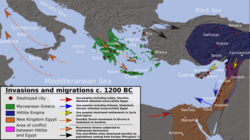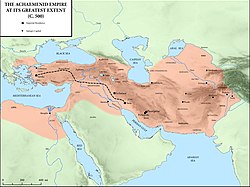Ancient Near East
The Ancient Near East is the name given to early civilizations within a region roughly corresponding to the modern Middle East: Mesopotamia (modern Iraq and Syria), Persia (modern Iran), Anatolia (modern Turkey), the Levant (modern Syria, Lebanon, Israel, Palestine, Jordan, and Cyprus), and Ancient Egypt, from the rise of Sumer in the 4th millennium BCE until the region's conquest by Alexander the Great in the 4th century BCE, or covering both the Bronze Age and the Iron Age in the region. As such, it is a term widely used in the fields of Near Eastern archaeology, ancient history and Egyptology. Some would exclude Egypt from the ancient Near East as a geographically and culturally distinct area. However, because of Egypt's intimate involvement with the region, especially from the 2nd millennium BCE, this exclusion is rare.
The ancient Near East is considered the cradle of civilization. It was the first to practice intensive year-round agriculture; it gave the rest of the world the first writing system, invented the potter's wheel and then the vehicular- and mill wheel, created the first centralized governments, law codes and empires, as well as introducing social stratification, slavery and organized warfare, and it laid the foundation for the fields of astronomy and mathematics.
Ancient Near East Media
Relief of early war wagons on the Standard of Ur, c. 2500 BC
Empires in the ancient Near East around the end of the 2nd millennium BC
Map of the Late Bronze Age Collapse (c. 1200 BC) in the Eastern Mediterranean
Siege engine in Assyrian relief of attack on an enemy town during the reign of Tiglath-Pileser III, 743–720 BC, from his palace at Nimrud
The Achaemenid Empire at its greatest extent c. 500 BC






